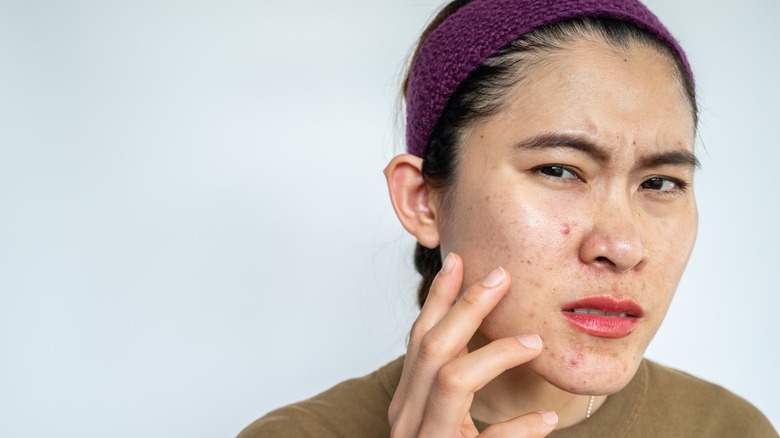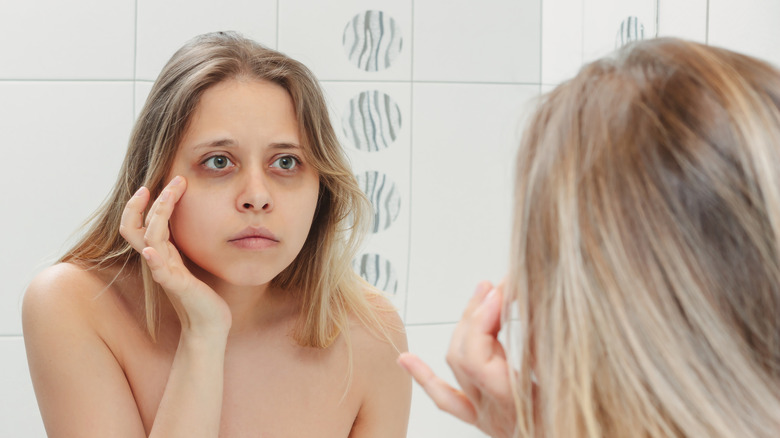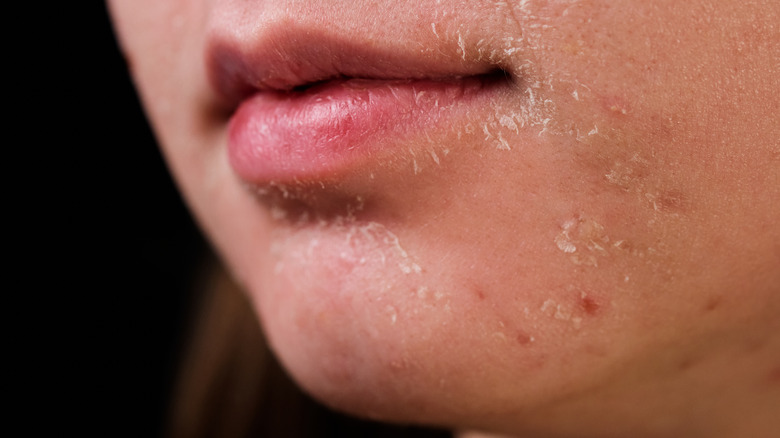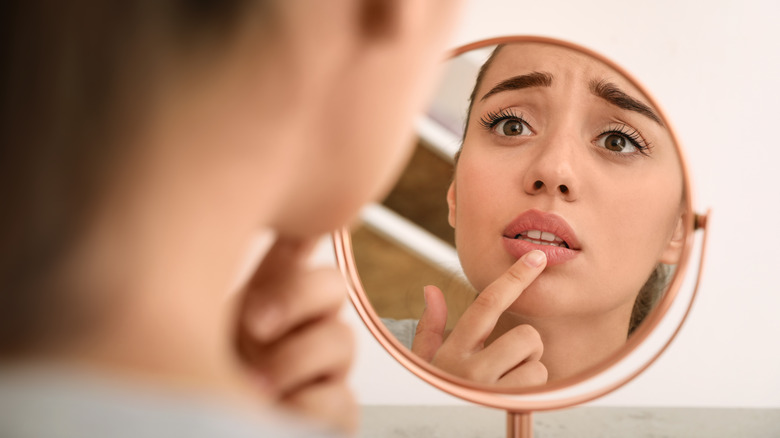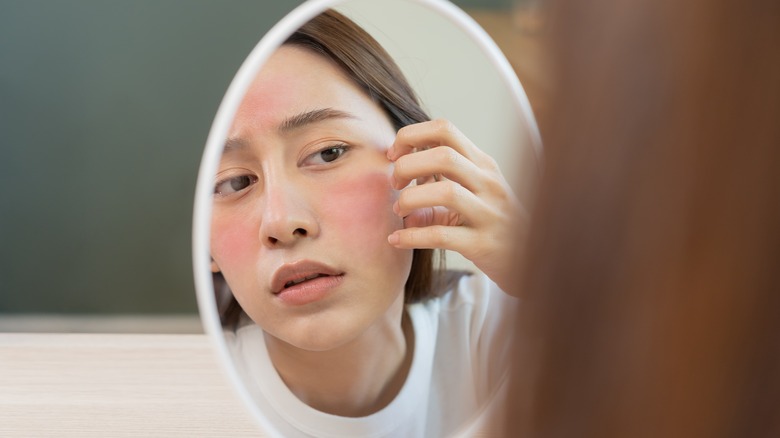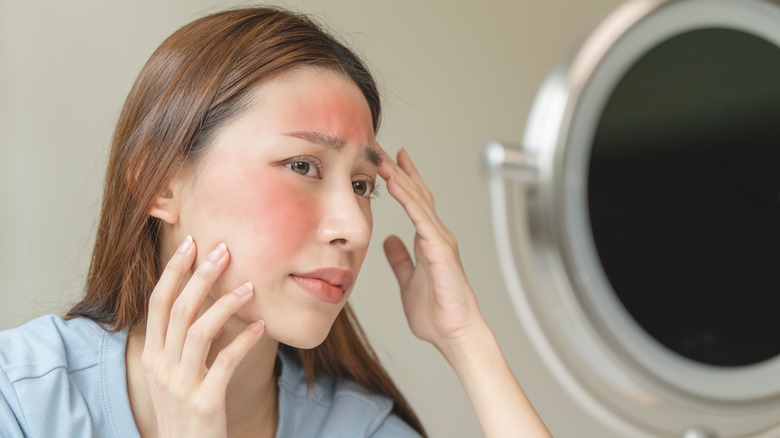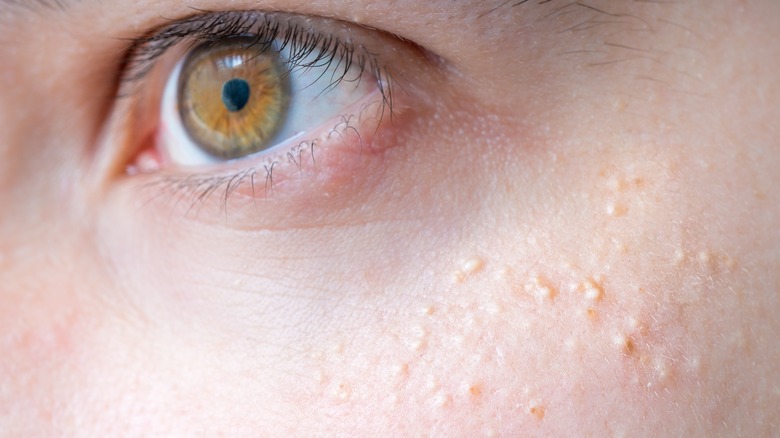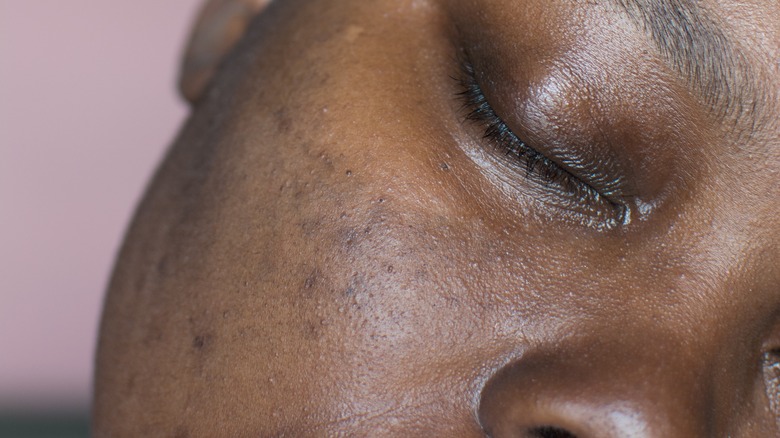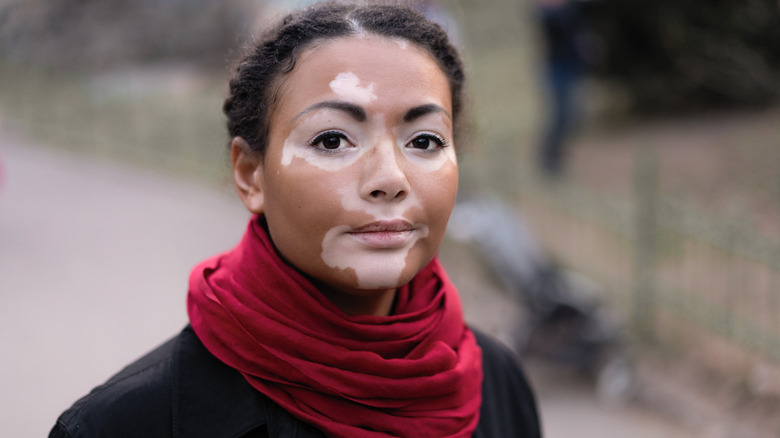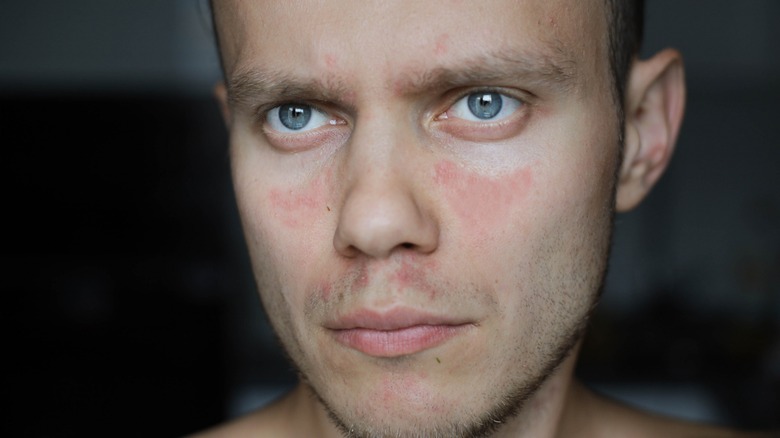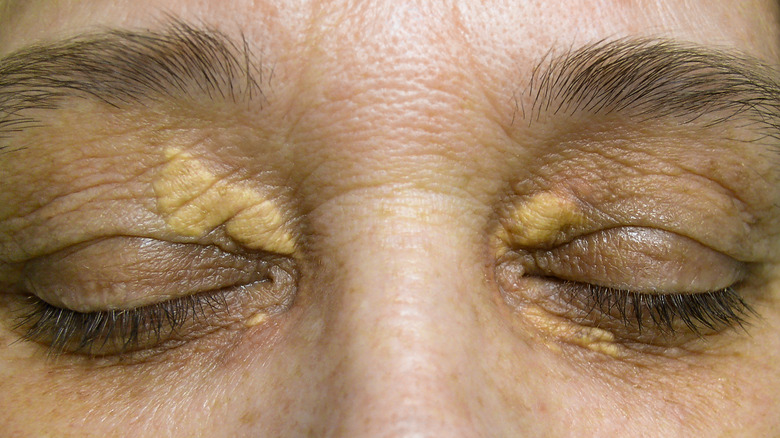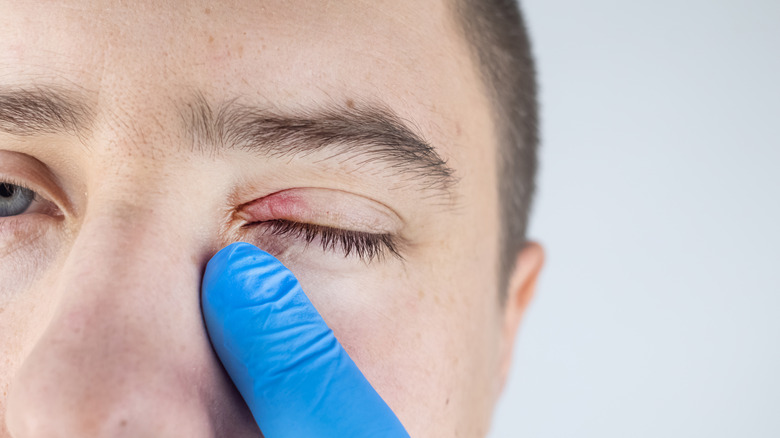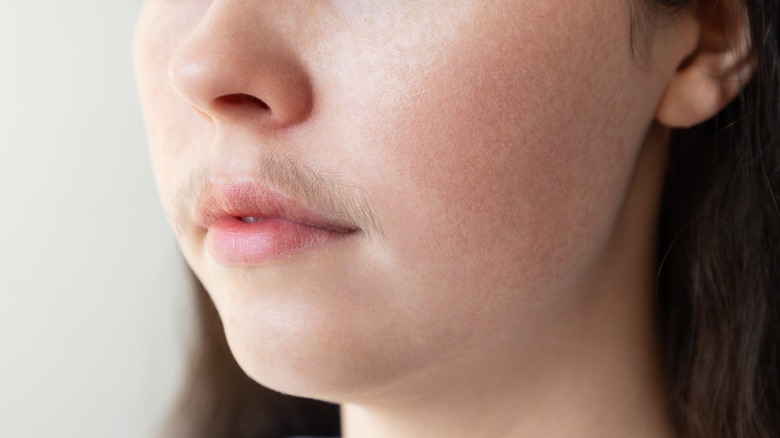Warning Signs On Your Face You Shouldn't Ignore
When you look at your face in the mirror, you're probably not looking for clues about your overall health and well-being. But your face can actually tell you a lot about what's going on in the rest of your body.
The color, texture, and dryness or oiliness of the skin on your face can all be warning signs that you're dealing with an underlying health issue that can impact a lot more than just your skin. Fluctuating estrogen levels and other hormonal imbalances, certain autoimmune conditions, diabetes, and other systemic conditions can all cause symptoms that show up all over your face. If you're not eating right, you're dehydrated, you're drinking too much alcohol, or smoking too much of anything, your face will let you know.
Not sure what your face is trying to tell you about your health? We've got you covered with this breakdown of the warning signs written all over your face.
Acne
Most of us know that acne and hormones go hand in hand during puberty, but did you know that hormones still have a major impact on acne when you're an adult? Tiny sebaceous glands in the skin produce an oily substance called sebum to keep the skin hydrated. These glands are really sensitive to hormones, especially testosterone. When hormonal shifts happen, the sebaceous glands make too much sebum, which clogs the pores, leading to all the blemishes that fall under the acne umbrella — whiteheads, blackheads, and pustules.
Adults assigned female at birth (AFAB) are more likely to have acne than adults assigned male at birth (AMAB). This might be because people with female reproductive organs experience monthly hormonal shifts with their menstrual cycles. In fact, any condition that causes hormonal imbalances can lead to acne. This is especially true with conditions like polycystic ovarian syndrome (PCOS) that cause the female body to produce excess testosterone. Folks struggling with PCOS often deal with persistent acne that's difficult to address with topical treatments.
Hormones aren't always to blame for acne, though. Acne can also indicate an allergic reaction to something you're putting on your skin, an issue with a medication you're taking, or a diet high in sugar.
Dark under-eye circles
Pretty much everyone has dealt with dark circles under their eyes at some point, and if you've assumed they're caused by sleep deprivation, you might be right. But they can also be a clue that an underlying condition or your lifestyle choices are impacting your overall health.
Cosmetic dermatologist Dr. Michele Green told Insider that dark under-eye circles can actually be a secondary effect of allergies. When allergies make your eyes itchy and watery, your natural reaction is to rub or wipe your eyes. This irritates the super fragile skin around your eyes, which leads to minor swelling and makes your dark circles worse. Green suggests taking an antihistamine on a regular basis and, whenever possible, avoid rubbing or wiping your eyes.
Some research indicates that dark under-eye circles can also be a sign of anemia, a condition in which the body doesn't produce enough red blood cells. In most cases, an iron deficiency causes anemia. When someone has anemia, the blood doesn't circulate oxygen the way it should, and that lack of oxygen can cause dark under-eye circles.
If you're not dealing with allergies or anemia, your lifestyle might be behind your raccoon eyes. Lack of sleep, smoking, and drinking too much alcohol can all contribute to dark under-eye circles. These habits aren't great for your overall health either. So, working toward healthier habits can give both your complexion and well-being a big boost.
Dry, flaky skin
We all have dry, flaky skin sometimes, especially during the winter. But if all the excellent skincare in the world isn't hydrating your face, it could be a sign of a medical issue that needs more than a good night cream.
Dermatologists from the University of Pittsburgh Medical Center state that many people with perpetually dry, flaky skin have skin conditions like eczema, psoriasis, or dermatitis. Each of these conditions has a different root cause and slightly different symptoms, but all of them can cause the skin to dry out and even peel. Only a dermatologist can determine which of these conditions is behind your skin problems and which treatments will be the most effective.
Lifestyle also plays a major role in your skin's hydration. If you're chronically dehydrated, you'll probably have persistently dry and flaky skin. If your diet is lacking Vitamin A, Vitamin D, niacin, iron, and zinc, your skin's hydration will suffer as well. Make sure you're getting 64 oz of water per day and eating a vitamin- and nutrient-rich diet.
Occasionally, more serious medical conditions are behind dry, flaky skin. Kidney diseases that impact the way your body processes liquids can dry out your skin. Diabetes and hypothyroidism have been linked to dry, flaky skin as well. If you and your doctor have ruled out the more common causes of dry skin, tests for kidney function, high blood sugar, and thyroid function could provide the answers you need.
Chapped lips
Like dry, flaky skin, chapped lips are a common problem that can usually be solved by drinking some more water and slathering on a good balm. But if your lips insist on staying dry and chapped, they may be trying to alert you to a bigger problem.
According to the National Library of Medicine, dry, chapped lips are actually a sign that your lips are inflamed. This often occurs because the lips get irritated by something they come into contact with. The irritant could be environmental, like prolonged exposure to hot, dry wind or cold temperatures; chemical, like a beauty product; or something you ate or drank. In some cases, these irritants cause an allergic reaction and a rash can form on and around the lips. Chemicals in lipstick are common irritants that cause dry, chapped lips.
When dry, chapped lips don't get better with hydration and over-the-counter chapstick or lip balms, they could be caused by a bacterial, viral, or fungal infection. Sores on chapped lips are the hallmark of the herpes virus. Both strep and staph bacteria can cause infections that lead to dry, chapped lips, and candida is the most common form of fungal infection on the lips.
When your lips are chapped and dry all the time, the first steps are to chug water and invest in a good lip balm. If that doesn't work, talk to your doctor about possible allergies or infections.
New or changing moles
Moles are dark growths on the skin that develop when skin cells grow in one area instead of distributing throughout the skin. According to WebMD, they can appear at any time throughout your life, though most appear before your mid-twenties. Some people are born with moles, but the majority of people don't have any moles at birth and develop them throughout their lives.
In general, moles are completely harmless, and it's normal to have quite a few by the time you're an adult. However, when new moles appear on your face or a mole you've had forever starts to change, it can indicate a problem.
When you're trying to decide if a new or changing mole is normal, shape and size are your best clues. Moles that are bigger than a pencil eraser and have irregular edges can be a sign of skin cancer. Asymmetrical moles, when one side of the mole looks different from the other side, can also indicate cancer. When a mole that you've had for a while starts to get bigger, change color, or change shape, that's a warning sign as well.
Though new moles and even changing moles can be completely normal, it's always best to check with a dermatologist if you're concerned.
Flushed cheeks
Any time your face turns red, whether you're blushing or post-workout, you're experiencing a physiological response called flushing. Healthgrades describes flushing as when blood vessels in the skin dilate and cause portions of the face — often the cheeks — to appear red for a short period of time. In most cases, flushing occurs when we feel big emotions, physically exert ourselves, eat spicy foods, and drink alcohol. But sometimes, flushing can indicate an underlying medical condition.
When flushing is the only symptom you're experiencing, it may be caused by a condition called rosacea. People with this condition get red in the face very easily, sometimes at the slightest trigger. Early on in the condition, the flushing subsides quickly. But as rosacea progresses, the redness sticks around longer, and eventually, it may not fade at all.
Flushed cheeks can also accompany hot flashes during menopause or certain kinds of headaches, like cluster headaches or migraines. Or if you have symptoms like fever, nausea, muscular pain, or sore throat along with a red face, it's possible you have a viral infection like Scarlet Fever or Yellow Fever. In rare cases, flushing can be a sign of a more serious medical condition like a thyroid disorder or cancer. If you get red in the face often or for seemingly no reason, check in with your doctor.
Red, blotchy skin
When random patches of red skin show up on your face, it's probably not the same as flushing, and it's probably not a simple physiological response. According to the American Academy of Dermatology Association, red, blotchy skin usually indicates a skin condition or an allergic reaction.
Seborrheic dermatitis, eczema, and psoriasis can all show up as red, scaly, or flaky rashes on the face. With eczema, the rash is often itchy. Rashes caused by psoriasis are often raised and more scaly than flaky. Both of these conditions are chronic, meaning they cannot be cured. However, they can be treated with topical or oral medications depending on the severity of your symptoms. Seborrheic dermatitis rashes are often oily, and can be easily treated with a skincare regimen from a dermatologist.
Allergic reactions are another common cause of red, blotchy skin. The allergen may be something you applied to your skin or something you ate or drank. Allergic reactions to medication can also manifest as a rash on the face. If you suspect that your red, blotchy skin is due to an allergic reaction, try to figure out what caused the reaction. This can be difficult as allergic reactions can happen suddenly, even with products you've used before. The rash will clear up once you remove the allergen.
In rare cases, your red, blotchy skin may be caused by a viral infection, like shingles, or an autoimmune condition, like lupus.
Bumpy skin
When little bumps show up on your face, you may assume that it's just a few pimples or maybe some acne. However, as Dr. John P. Cunha explains in an article for eMedicineHealth, common skin conditions, allergic reactions, issues with the hair follicles, and the buildup of dead skin cells can all be behind your bumpy skin.
Though eczema and rosacea typically show up as flat rashes, they can sometimes cause small bumps on the skin as well as a rash. Dermatitis, another common skin condition, can also cause a bumpy rash that looks a lot like an acne breakout. The rash usually shows up around the mouth, nose, or eyes.
When red, itchy bumps suddenly appear on your face, an allergic reaction called hives may be the culprit. Hives can be triggered by something that touched your skin or something you ate or drank. They usually go away if you take antihistamines. If not, they typically resolve within 24 hours. If your hives don't respond to medications and persist longer than a day, you may need a steroid cream prescribed by a dermatologist.
Folliculitis, an infection of the hair follicles in your face; keratosis pilaris, a buildup of dead skin cells that form a bump; and milia, small keratin-filled cysts on the face, can all cause bumpy skin as well. A dermatologist can help you determine which condition is behind your bumpy skin and come up with a treatment plan.
Dark spots
Most of the time, when a dark spot shows up on your face, it's no big deal. They're usually harmless moles or they may be sun spots, which are caused by prolonged exposure to the sun. Though you may not love these new spots, they aren't a sign of a medical issue and usually don't need treatment. However, the dermatologists at Advanced Dermatology of the Midlands warn that new dark spots on your face may be warning signs if they're large, oddly shaped, or raised and rough.
Seborrheic keratosis is a common skin condition that causes dark, raised, scaly growths on the face. These growths are harmless and don't require treatment. However, most people don't like their appearance. Dermatologists suggest slathering Vaseline on the growths to treat the scaly skin they cause and reduce their appearance.
Conditions that cause inflammation in the skin can also lead to what's called post-inflammatory hyperpigmentation. Sometimes, when a bit of skin is inflamed for a long period of time, the pigmentation of the skin actually changes, leaving behind a dark spot even after the inflammation resolves. Persistent acne is a common cause of post-inflammatory hyperpigmentation.
Large dark spots that have ragged, blurred, or irregular edges, an odd shape, or appear to be more than one color can be signs of melanoma, a form of skin cancer. Any time you're concerned about a new dark spot, it's always a good idea to see a dermatologist.
Light spots
Unlike dark spots, light spots on your face are usually a sign of a medical condition. This is especially true for people with dark skin, according to the American Academy of Dermatology Association.
Vitiligo and tinea versicolor can cause light spots on both light and dark-skinned people. Vitiligo is an autoimmune condition that causes patches of skin to lose their pigmentation. These patches often show up on the face and neck. Tinea versicolor is a fungal skin infection that shows up as light, dry, scaly patches of skin. For people with light skin, pityriasis alba, is a common skin condition that causes small, light, scaly spots on the face.
Common skin conditions like eczema, psoriasis, and seborrheic dermatitis all look different when they appear on dark skin. Instead of showing up as red, scaly, or flaky rashes, these conditions show up as light-colored rashes on dark skin. It's important for people with dark skin to see an experienced dermatologist as rashes on dark skin are often misdiagnosed.
In rare cases, light spots on the face can indicate a serious medical condition. Scleroderma is an autoimmune disease that causes hard, light spots on the skin. Hansen's disease, commonly called leprosy, can also cause flat, light spots to appear on the skin. Both conditions require immediate medical treatment. Another autoimmune condition called lupus, which produces a distinct rash on the cheeks, can show up as a light-colored rash on dark skin rather than the characteristic red rash.
Butterfly rash
A butterfly rash, also called a malar rash, can easily be confused with flushing, which turns the cheeks red during physical exertion or strong emotional reactions. The big difference is that a butterfly rash covers the nose as well as the cheeks. According to the National Library of Medicine, the malar rash fans out over the cheeks, connecting over the bridge of the nose, so the cheeks look like butterfly wings and the nose looks like a butterfly's body.
Though malar rashes can indicate multiple medical conditions, they're most often a sign of lupus. This autoimmune disease causes a person's antibodies to attack healthy tissue instead of diseased tissue. The skin, kidneys, and joints are the most common targets of dysfunctional antibodies, though the heart and brain can also be affected. Lupus causes a butterfly rash when the antibodies responsible for responding to allergic reactions respond to healthy skin cells as if they were allergens. This response is often triggered by sun exposure.
Butterfly rashes can also be signs of rosacea, an inflammatory skin condition that causes red rashes on the cheeks; erysipelas, an infection of the upper layers of the skin; or cellulitis, an infection of the deeper layers of skin and the fat below the skin. In rare cases, malar rash can also be caused by pellagra, a systemic disease caused by a niacin deficiency, or dermatomyositis, a disease that affects the skin and muscles.
Yellow spots on the eyelids
When fats or lipids build up in the body, they can create small, yellow growths on the eyelids. These growths, called xanthelasma, can be flat or protrude slightly, giving the skin a raised appearance, according to the American Academy of Ophthalmology.
The growths are harmless, and they don't require treatment. However, they can be a warning sign of heart disease. The growths can indicate that your cholesterol levels are high, which can lead to blocked arteries. About 50% of people with xanthelasma also had high cholesterol, so it isn't always a sign that there's a problem. That being said, if you notice these growths on your eyelids, it's a good reason to get your cholesterol levels checked.
Xanthelasma doesn't have to be removed, but many people opt to do so for aesthetic reasons, especially since they can grow larger over time. Depending on the location and size, the growths can be removed with laser surgery, cryotherapy, an electric needle, certain chemical peels, and traditional surgery.
Red or dry skin around the eyes
The skin around the eyes is much more fragile than the rest of the skin on your face, so it can get irritated pretty easily. If you have red or dry, flaky skin around your eyes, it may be harmless irritation. However, as board-certified ophthalmologist Dr. Nishika Reddy explains in GoodRx, red, dry skin around the eyelids can be a warning sign of allergic reactions, infections, dermatitis, or even an autoimmune disease.
The most common cause of red, dry skin around the eyes is dermatitis, which is a catch-all term for inflamed skin. This inflammation can be caused by any substance that comes into the contact with the skin around the eyes. Common culprits are cosmetics, cleansers, perfumes, and your makeup brushes and sponges, especially if they're not too clean.
Allergic reactions that start on the hands, like when you touch poison ivy, poison sumac, or poison oak, can be transferred to the skin around the eyes if you touch them with your irritated hands. Multiple varieties of viruses and bacteria can cause red, dry skin around the eyes as well. These include shingles, cellulitis, and blepharitis.
Excess hair
Pretty much every person assigned female at birth (AFAB) deals with an occasional chin hair or a fuzzy upper lip every so often. But if your facial hair growth situation includes peach fuzz that borders on a mustache, beard, or both, then it's a warning sign that something's not right.
According to Cleveland Clinic, both AFAB people and people assigned male at birth (AMAB) produce hormones called androgens, but the levels are much higher in AMAB folks. When AFAB people's bodies make more androgens than normal, they can develop a condition called hirsutism. Facial hair growth is the primary symptom of hirsutism, but in some cases, AFAB folks with this condition begin having symptoms associated with male puberty. This can include voice drops, increased libido, changes to muscle development, clitoral growth, and smaller breasts.
Sometimes hirsutism occurs because of a natural hormone imbalance or specific medications. However, it's usually a secondary condition, meaning that an underlying disease causes hirsutism. The most common disease that causes hirsutism is polycystic ovarian syndrome (PCOS). PCOS triggers AFAB bodies to produce excess androgens, which leads to menstrual problems, fertility issues, acne, weight gain, and hirsutism.
Cushing's syndrome, a condition caused by excessive production of the stress hormone cortisol, can also lead to hirsutism. In rare cases, hirsutism is caused by a tumor on the adrenal glands or ovaries. If you notice more hair on your face, especially if it's accompanied by acne, make an appointment with your gynecologist ASAP.

